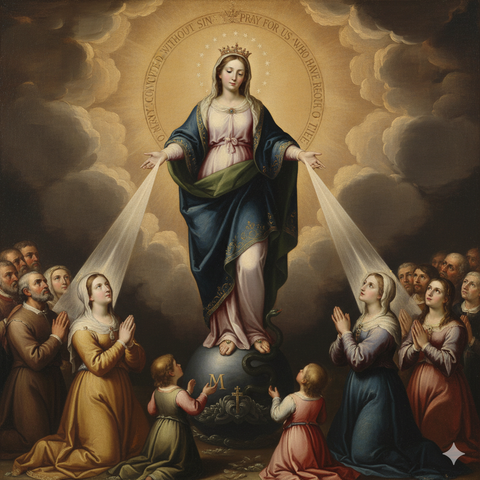The sun was lowering over the hills of Galilee. In the small village of Cana, laughter echoed through narrow streets as family and friends gathered for a wedding feast — a celebration that, in Jewish tradition, could last several days.
It was a joyous affair. Music, dancing, and shared food filled the courtyard. Guests reclined at low tables while servants moved briskly with earthenware jugs of wine — a symbol not merely of festivity, but of blessing and covenant joy. In Jewish custom, hospitality was sacred: to run out of food or drink would bring deep embarrassment and public shame upon the families of the bride and groom.
Among the guests was the Blessed Virgin Mary. Quiet and observant, she noticed what others had not yet seen — the anxious glances of the servants, the whispered worry spreading near the wine jars. The supply was gone.
Moved by compassion and understanding the gravity of the moment, Mary approached her Son and said: “They have no wine.”
Jesus said to her, “Woman, what is that to Me and to thee? My hour is not yet come.”
His Mother said to the servants, “Do whatever He tells you.” (John 2:3–5)
Six large stone jars stood nearby, used for the Jewish rites of purification. Jesus told the servants to fill them with water. They filled them to the brim. Then He said, “Draw out now, and bear to the chief steward.”
When the steward tasted it, he marveled — for the water had become wine, and not just any wine, but the best that had been served all evening.
And so, in that humble Galilean village, through Mary’s quiet intercession, Jesus performed His first public miracle — the beginning of His public ministry. Grace entered the world’s stage through the words of a Mother who saw a need and brought it to her Son.
The Miracle That Revealed the Mediatrix
The Wedding Feast of Cana was more than an act of compassion; it was a revelation.
In that quiet exchange between Mother and Son, heaven unveiled Mary’s eternal mission — to be the channel through which divine grace flows to humanity.
Jesus, true God and true Man, did not need His Mother’s prompting to know the needs of men. Yet, in His divine wisdom, He chose to respond to her intercession. By doing so, He affirmed forever that the path of grace is not only vertical — from God to man — but also maternal, flowing through the Immaculate Heart of His Mother.
Mary did not perform the miracle. She did something greater: she interceded for it. She spoke once, with complete trust — “They have no wine” — and then she stepped back, confident that her Son would answer in His time and His way.
Through her request, Jesus sanctified the very pattern of mediation that would mark His Church: all grace originates from Him, but it is His will that it passes through Mary, the first and most perfect disciple, before reaching us.
The Church’s Voice: Mary, Channel of All Grace
Through the centuries, the Church has meditated on this truth.
Pope Leo XIII wrote with clarity and warmth: “No one goes to Christ except through His Mother; as by her aid He came to us, so by her aid we must go to Him.”
Pope St. Pius X deepened this teaching, declaring: “From her hands, as from the purest of channels, flow down upon us the streams of divine grace.”
And Pope Pius XII described her role in salvation as one “in union with her Son’s sufferings, becoming the treasurer of all graces which Jesus merited for us on the Cross.”
What began at Cana — water changed into wine at her request — found its fulfillment at Calvary, when water and blood flowed from the side of Christ, the fountain of redemption. And Mary stood there too, at the foot of the Cross, uniting her heart to His. From that hour, she became not only Mother of Jesus, but Mother of all who live in grace.
Saints and mystics have echoed this divine mystery.
St. Bernard of Clairvaux wrote: “It is the will of God that we should have nothing which does not pass through the hands of Mary.”
St. Louis-Marie de Montfort beautifully summarized it: “To go to Jesus through Mary — this is the path that is most short, most perfect, and most secure.”
The Mother Who Still Sees the Empty Jars
Two thousand years later, the scene at Cana continues to repeat itself in every age. Our jars, too, run dry — not of wine, but of peace, hope, faith, or love. And again Mary notices.
She still sees before we even speak. She still brings our need to her Son.
And her message to every soul remains unchanged: “Do whatever He tells you.”
Mary does not replace Jesus; she leads us unfailingly to Him. She is the bridge, not the destination — the Mother whose only desire is that we come to love her Son as she does.
A Call to Consecration
To entrust oneself to Mary is to place our lives within the same hands that carried Jesus, comforted Him, and pointed others to Him.
When we consecrate ourselves to her Immaculate Heart, we allow her to shape our souls, to purify our intentions, and to present us — like the wine at Cana — transformed by grace.
Pray daily the Act of Consecration to the Sacred Heart of Jesus and the Immaculate Heart of Mary, and let this prayer become your “Cana moment."
Through her intercession, every empty jar can be filled again — not with mere wine, but with the sweetness of divine grace.
For from the Heart of Jesus, through the hands of His Mother, all blessings flow.
_______________________________________________________________________________________________
If this reflection brought you peace, share it with someone in need of hope today. Let us entrust every joy, sorrow, and empty jar to Mary, Mediatrix of All Grace — our Mother, our refuge, and the surest path to her Son.

